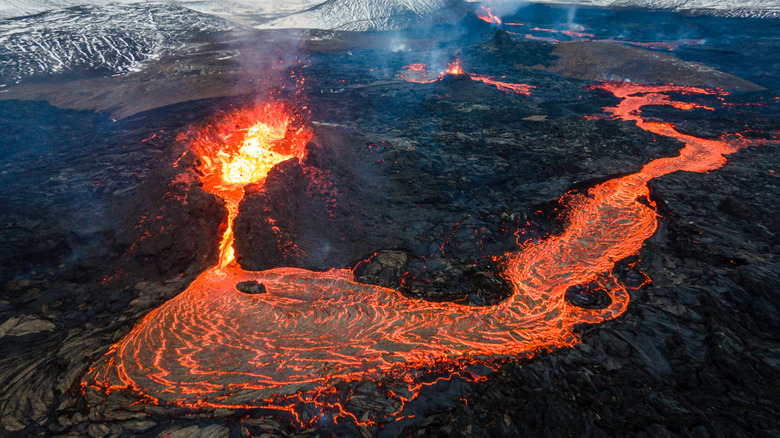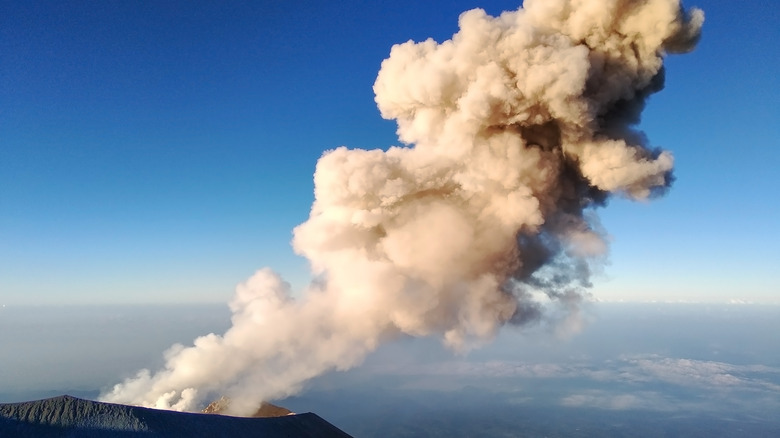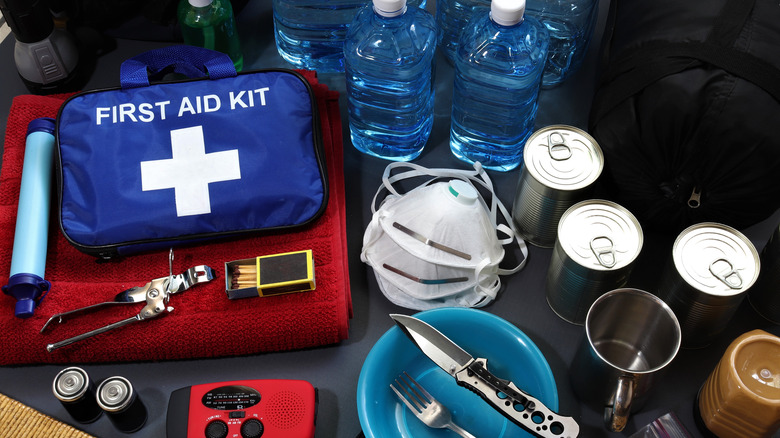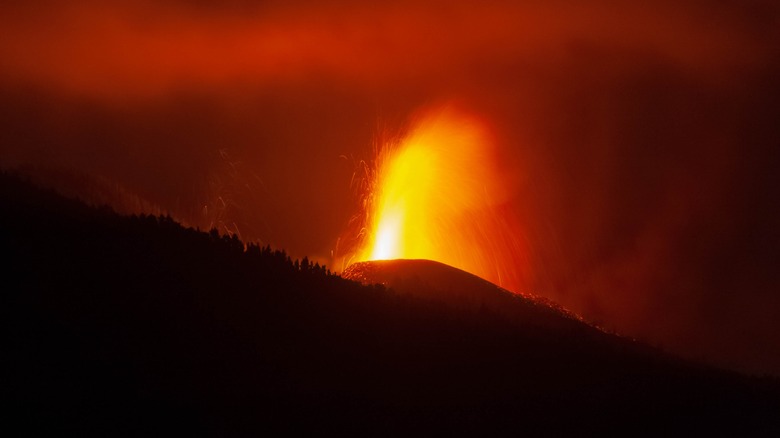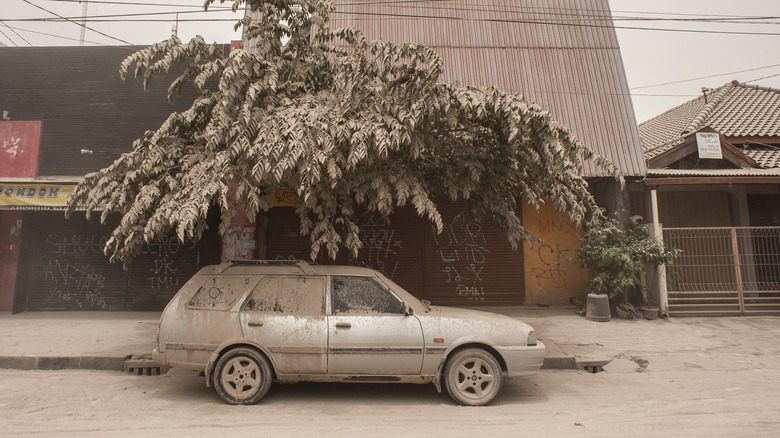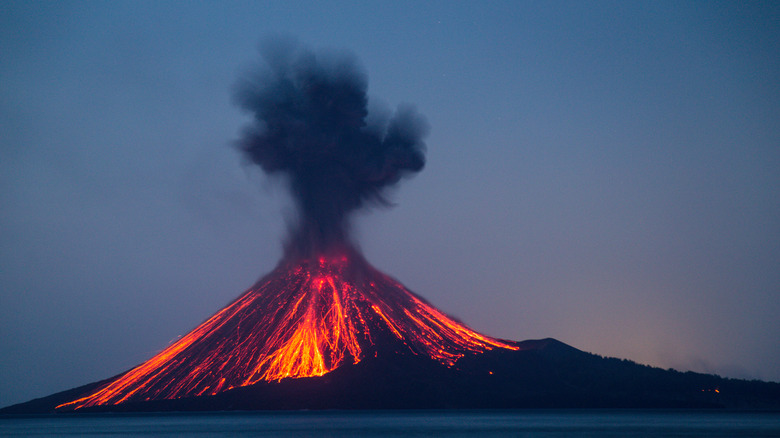How To Stay Safe During A Volcanic Eruption
There are 161 active volcanoes in the United States alone. If you live in an area near a volcano, knowing how to stay safe during a volcanic eruption can quite literally save your life. While Hawaii is home to the world's largest active volcano, other states with large numbers of volcanoes include Alaska, California, Washington, and Oregon (via Ready.gov). Volcanoes are also present in other states, so be sure to see if your home is near one.
While it is important to be prepared in case of a volcanic eruption, don't spend too much time worrying about whether a volcano will erupt near you. Generally speaking, it is normal for volcanoes to go extremely long periods of time without erupting, so it is unlikely that one will erupt near you (via the American Red Cross). That being said, it never hurts to have a plan in case one does decide to blow. Here are some ways to stay safe during a volcanic eruption.
What happens during a volcanic eruption?
Volcanic eruptions are caused by magma rising through the Earth's crust. This rising magma causes pressure to build up underground, eventually causing an eruption. During a volcanic eruption, lava (the name for magma when it is above ground), ashes, gas, dust, and rocks are spewed out of the ground (via Expatriate Healthcare). Volcanic eruptions can contaminate water supplies, damage machinery, reduce visibility, make it hard to breathe, and irritate the eyes, skin, nose, and throat (via Ready.gov).
There are two types of volcanic explosions: effusive and explosive. Effusive eruptions tend to have steady lava flows on the ground, and are much less likely to send rocks flying. These eruptions can take a long time to diminish, but usually give those effected more time to evacuate. Explosive eruptions are violent explosions that send debris everywhere. These eruptions give very little time to evacuate and can cause heavier ash fall than effusive eruptions (via Britannica).
Be prepared with a plan before an eruption occurs
As with any emergency, you should have a plan for a volcanic eruption before one occurs. This is especially important if you live near a volcano. The most important steps you should take in advance are knowing your areas risk, stock up on emergency supplies in advance, practice communication and evacuation plans, and keep important documents in a safe place (via Ready.gov). It is also important to look into what types of damage your insurance will cover if your home, car, or belongings were to be affected.
If you need to evacuate, bring a radio with you to listen for updates. Fill your gas tank, clean water containers, and take only essentials. Evacuate as early as possible. If you have time, turn off your home's gas, electricity, and water (via the CDC). Be sure to follow designated evacuation routes, as other roads may be blocked.
Stay inside and seek high ground
If you are not instructed to evacuate, or do not have time, it is important to stay inside. Close windows and doors, as well as your fireplace or woodstove dampers if you have them. You will want to seal yourself inside as best as you can. Turn off fans and AC systems to prevent ash from getting inside.
If you're outdoors and can't make it inside, protect yourself however you can. If there is rockfall, roll yourself into a ball to protect your head. Move uphill if possible if near a stream or a river, as the water may rise and cause dangerous flash floods and mudflow. If you are burned, seek immediate burn care (via the CDC). If you are outside during the beginning of an eruption, you may see a phenomenon known as volcanic lighting. This is a normal part of some eruptions.
Protect yourself during the ashfall
During a volcanic eruption and the time afterwards, you will have to watch out for ash fall. If you can, it is important to stay inside with windows and doors closed. Wear long-sleeved shirts and pants, goggles, and masks to protect yourself from the ash. If possible, a respirator will do a better job protecting your airway from ash than just a mask, but use whatever you have on hand (via the CDC).
Avoid driving during ash fall if at all possible. If you must drive, turn off your AC to prevent ash from getting inside your car. Once it's safe to go outside, it is important to clear the ash off your roof as soon as possible, as the weight of it can cause substantial damage to your roof (via the American Red Cross). Do the best you can, but don't risk your health or life and be extra cautious (via Ready.gov).
Pay attention to warnings from local authorities
After the eruption is over, it's important to pay attention to local authorities in order to know how to proceed. If you have evacuated, do not return until authorities say it is safe. If you're inside, stay inside until you're told it's safe to go out (via Expatriate Healthcare).
Update your family and friends as soon as possible through texts and social media. Phone lines are often busy after a disaster, so only make calls in an emergency. When it's safe to begin cleaning up, wear protective clothing and a mask. Do not let children assist in cleaning, as their lungs are more susceptible to damage from the ash (via Ready.gov). Continue to listen to local news or NOAA weather radio for updates and instruction as the situation calms down (via the American Red Cross). The keys to surviving a volcanic eruption are staying informed and following instructions.
